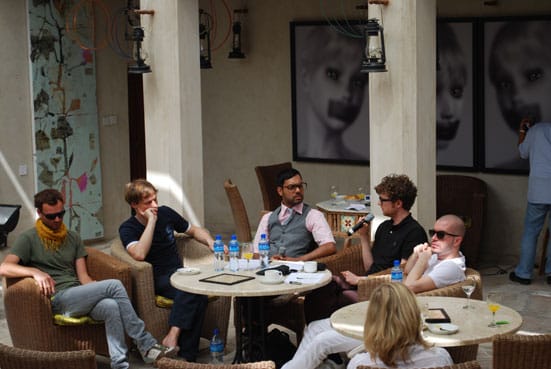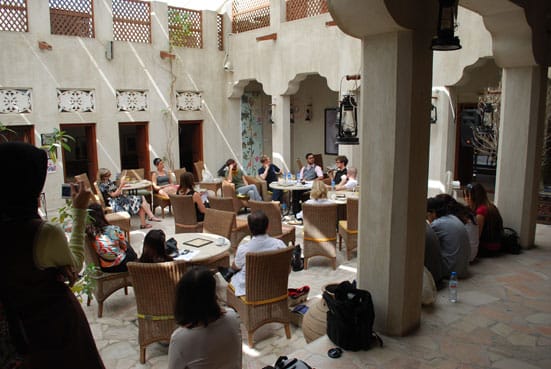Sara Raza is a London based independent curator, writer and co-editor of ArtAsiaPacific magazine (West and Central Asia).
BAF Art School (16 – 20 March 2009) was an organic five-day free morning art school for members of the public, students, emerging artists, critics and collectors throughout the UAE and internationally to engage in vibrant discussions on trend with current contemporary art practice now. The programme, curated by Sara Raza, a former curator of public programmes at Tate Modern, presented a compact and lively series of talks and artist presentations designed to offer an alternative art curriculum to coincide with Art Dubai and Sharjah Biennial.
The sessions covered a range of current topics: Surveillance, Power & Control: Who’s Zooming Who? ; The New Black: Are Art Fairs the New Biennials? ; Friendship of the Peoples: Contemporary Collaborations ; You Can Take the Artist Out of the bazaar, but Can You Take the Bazaari Out of the Artist? and culminated in Gossip & Rumours: An Art Quiz With a Difference, with quiz mistress, artist Yara El-Sherbini.
AM: So how did this project in Dubai come about?
SR: Bastakiya Art Fair (BAF) is the UAE’s only fringe art fair, which takes place in the heritage area of Dubai in March since 2008 and is organised by XVA gallery and a coalition of local UAE galleries and artists who take over a series of houses for the week long fair, with a strong emphasis on curated cutting edge programmes. I was invited by the director Emily Doherty, whom I met in Abu Dhabi last year, to come on board and devise an education programme to coincide with the fair so I thought about integrating the concept of a school given the fact that there are no informal art dialogue platforms in Dubai. The faculty was very fluid and consisted of 18 fellow art colleagues, artists, critics and curators based in the region and those travelling and working in the UAE, such as the Dhakha/ New York based artist Naeem Mohaiemen who recently had a group show at the Third Line Gallery in Dubai and critic and curator Shumon Basar, who is currently writing a fiction novel on the region as well as group of artists, architects and designers who have formed an alliance called Dubai-Dusseldorf 1 and are working between the two diverse cities to create a cultural platform. Working with such a diverse group of art professionals was such a pleasure and largely contributed to the success of the project.
AM: Were you pleased with how the Art School went, what were some of the highlights for you? Did the Art School also function as a networking event?
SR: BAF Art School for me was really an experimental platform that was attempting to address the void in informal visual art and cultural dialogue in the region, it was open to the public and was free and provided an environment where one could have brunch and listen to art conversation in the company of internationally operating artists, critics and curators. Concurrent with BAF was the Sharjah Biennial March Meetings and the Global Art Forum at Art Dubai, which in comparison were more formal and academic in approach and what BAF was trying to offer was a more informal approach aimed at enticing the general public as well as contemporary art enthusiasts to engage with art education in a less elitist and intimidating manner.
AM: The sessions covered a range of important contemporary issues, did you come away with any new perspectives on these subjects?
SR: When devising the art school I was aware that I had to design a programme that was context specific and took into consideration the local audience and scene, which is an emerging one compared with the more established contemporary art centres in the region like in Tehran, Beirut or Cairo, which have been active for several decades. I found that the dialogue I was initiating functioned more as an introduction or taster to a real need for arts education on a more permanent basis, beyond the annual art fair and biennial calendar.
AM: What was your experience of Art Dubai? Has the recession started to bite yet?
SR: I had a sense that the fair was definitely more downsized, in comparison with last year, which in some ways allowed you to see the art and navigate the fair more easily. However, the usual throng of international Asian collectors were on the scene, but there was definitely a desire for quality over quantity. In recent years to every good artist there have been at least 20 bad imitators, and there seems to be a lot less of that since this economic downturn, so perhaps the global financial crisis isn’t entirely all bad?
AM: What was the Sharjah Biennial like this year? Did any artists emerge from the region as ‘ones to watch’?
SR: The 9th Sharjah Biennial was definitely more focussed on process rather than production and was fairly experimental in nature, for example half of the artists in curator Isabel Carlos’ selection were handpicked from an open submission, which is a unique policy that most biennial’s do not adhere to, also the biennial was not limited to geography. Outstanding artists of the biennial included Pakistani artist Hamra Abbas’s installation of miniature paintings ‘God Grows on Trees’, (2009) depicting portraits of 99 school children, an ode to the 99 names of god in Islam, who attend a local religious school in Rawalpindi, Pakistan and learn the art of Zikr, the Islamic act of reciting the name of god and simultaneously learning to master one’s breathing. Also of note was new comer Lamya Gargash a Dubai born artist whose photographs of Emeriti homes provided a candid insight into the private spaces of local UAE citizens, her work will also be featured in the inaugural UAE pavilion at the upcoming Venice Biennial.
AM: What other current developments are there in the UAE region, art-wise?
SR: The region is a cultural scene in the making that is occurring at a breakneck speed and has benefited greatly from an unscrupulous oil wealth and zero taxation laws in the thriving city of Dubai that has swiftly developed as a center for buying and selling art and is home to a number of galleries such as the Third Line, B21 and XVA and auction houses Christie’s and Bonhams. Of course the most exciting project is the much talked about Museum Island in Abu Dhabi, that will boast the world’s largest branch of the Guggenheim franchise and the Lourve by 2012. However, beyond the commercial success and proposed museum hub there is a still a great need to create working conditions for artists and arts professionals, such as affordable studios, regular informal gatherings such as BAF Art School, exhibition venues and more arts patronage so that artists, critics and curators can thrive. At the moment there are no art school dedicated to contemporary art and visual cultural in the region and arts education is an important factor in creating a sustainable local arts scene.
AM: What is the future of BAF Art School, will it continue next year?
SR: I am hoping to curate a similar programme next year with the return of BAF Art School in March 2010 with a new faculty of artists, curators and critics and perhaps integrate it more with higher learning whereby students could get some credit for attending and taking part as well as inviting international curatorial and fine art students to take part. There are also plans to make use of some of the historical houses and create a site specific programme.
Ali MacGilp and Sara Raza

BAF Art School, Dubai, March 2009

BAF Art School, Dubai, March 2009